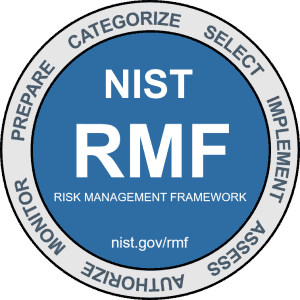The National Institute of Standards and Technology (NIST) Risk Management Framework (RMF) is a robust, adaptable method for managing and mitigating information security risks within government agencies and organizations working with government systems. It integrates security, privacy, and cyber supply chain risk management into the system development life cycle. The RMF enables continuous cybersecurity risk management, compliance assurance in diverse environments, and enhanced supply chain and personnel security.
NIST plays a pivotal role in providing guidance and standards for federal agencies and their information systems and organizations. This extends to vital sectors like the Department of Defense (DoD), where robust security measures are essential.
NIST’s comprehensive framework aids federal agencies, including the DoD, in ensuring the security and resilience of their federal information systems. By adhering to NIST’s guidelines and recommendations, federal agencies can strengthen their cybersecurity posture, protect sensitive data, and mitigate risks effectively, aligning their operations with best practices and safeguarding national interests.
The 7 NIST Risk Management Framework Steps
The NIST Risk Management Framework (RMF) consists of seven steps that guide organizations through the RMF process of managing and mitigating risks associated with information security. These steps are as follows:
- Prepare: This step involves preparing the organization to manage security and privacy risks.
- Categorize: This step involves categorizing the system and information based on impact analysis.
- Select: This step involves selecting the set of NIST SP 800-53 controls to protect the system based on risk assessment(s).
- Implement: This step involves implementing the security controls.
- Assess: This step involves assessing the effectiveness of the security controls.
- Authorize: This step involves making risk-based decisions to authorize the system.
- Monitor: This step involves continuously monitoring security controls to ensure they are operating as intended and producing the desired results.
What is NIST SP?
NIST’s publications are considered authoritative in the field of cybersecurity and are widely used to help organizations and individuals strengthen their security postures and protect sensitive information. Many of these publications are often used by government agencies, businesses, and individuals to improve security practices and ensure NIST compliance standards. Some of the key NIST publications in the context of cybersecurity include:
NIST Special Publication (NIST SP): these are perhaps the most well-known publications in the field of information security. They cover topics such as risk management, encryption standards, security controls, and guidelines for securing various technologies.
NIST Interagency Reports (IRs): These reports often document research and recommendations for various technical and scientific topics, including cybersecurity.
NIST Federal Information Processing Standards (FIPS): These are specific standards and guidelines that federal agencies are required to follow for securing information and technology systems.
NIST Cybersecurity Framework: This framework provides guidance for organizations to develop and improve their cybersecurity risk management processes.
NIST Computer Security Resource Center (CSRC): The CSRC provides access to a wealth of information, including guidelines, standards, and publications related to computer security.
NIST Cybersecurity Practice Guides: These guides provide practical, step-by-step instructions for implementing various cybersecurity solutions and best practices.
NIST Security Bulletins: These contain alerts, updates, and other information related to current cybersecurity threats and vulnerabilities.
What is RMF vs CSF?
NIST Risk Management Framework (RMF) is primarily aimed at the federal government and its contractors, with a specific focus on managing risks in government information systems in the United States. On the other hand, the NIST Cybersecurity Framework (CSF) is a more general framework that can be used by a wide range of organizations to enhance their overall cybersecurity practices. While there may be some overlap between the two frameworks, they have different scopes and intended audiences. Many organizations may choose to use both frameworks in conjunction to achieve comprehensive cybersecurity and risk management.
NIST Risk Management Framework (RMF)
As stated above, RMF target audience is primarily designed for government agencies and contractors that handle sensitive government information.
- NIST Cybersecurity Framework (CSF) is a more general framework designed to help organizations, both public and private, manage and improve their overall cybersecurity posture. It is a voluntary framework that can be adopted by a wide range of entities.
- The RMF provides a structured process for managing risks throughout the entire system development and operational lifecycle. It emphasizes continuous monitoring and authorization of information systems.
- The RMF also includes the 7 steps for mitigating and monitoring risk.
NIST Cybersecurity Framework (CSF)
NIST Cybersecurity Framework (CSF) is a more general framework designed to help organizations, both public and private, manage and improve their overall cybersecurity posture. It is a voluntary framework that can be adopted by a wide range of entities.
- CSF target audience is intended for organizations of all types and sizes, including critical infrastructure sectors, businesses, and government agencies.
- The CSF is built around five core functions: Identify, Protect, Detect, Respond, and Recover. These functions help organizations address various aspects of cybersecurity, from risk management to incident response.
- The CSF is highly flexible and can be adapted to an organization’s specific needs and circumstances. It provides guidance on how to assess and improve an organization’s cybersecurity posture.







